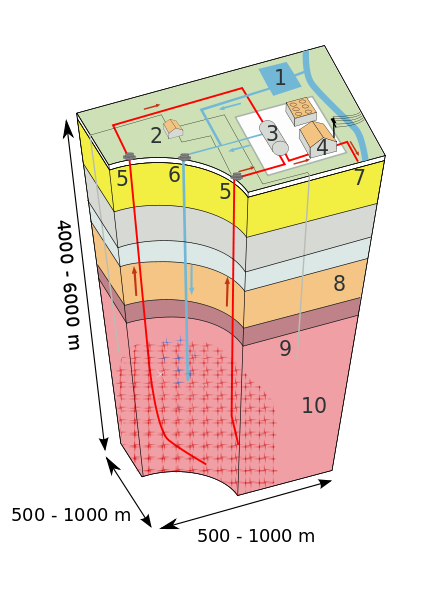Hot on the heels of the election, geoscientists are recommending what should be an obvious change of direction for our energy policy; instead of wasting another $72 billion on subsidies for corporations building legacy ineffective green energy technology, the Obama administration should be funding basic research with that money instead.
Mark Zoback, a professor of geophysics at Stanford who served on the U.S. Secretary of Energy's Committee on Shale Gas Development, will be on a panel with Jeff Tester, an expert on geothermal energy from Cornell University, and Murray Hitzman from the Colorado School of Mines at the American Geophysical Union (AGU) meeting in San Francisco on December 4th to talk about the future of American energy.
"One option for transitioning away from our current hydrocarbon-based energy system to non-carbon sources is geothermal energy – from both conventional hydrothermal resources and enhanced geothermal systems," Zoback said in a statement.
If you think anti-science hippies have a problem with natural gas fracturing and all that cancer and causing the Earth to deflate they claim have resulted, wait until enhanced geothermal gets into their fundraising brochures (and it will - activists have never found any issue first, science always has, and then they raise money worrying about it and telling their base science is out to kill us). Regular geothermal power is passive, geysers or hot springs drive a turbine - it's also pretty useless unless you want 10% efficiency but, inefficient or not, the US leads the world in it, with over 3,000 MW of capacity from nearly 80 power plants. Those geothermal plants are doing what just 3 average nuclear plants can do with much less environmental impact but convection geothermal is natural and renewable and good enough Iceland that can use it for 30% of their power. They don't have a lot of people in Iceland.
Enhanced geothermal is like natural gas fracking, except for heat contained underground. They pump water through an injection well with literally enough force to fracture granite and any other hot rocks in the way. Those fractures and the pressure means the water circulates and becomes hot and then another well brings it back to the surface where the steam drives a turbine just like in a regular convection geothermal scheme. The steam cools back into water and is re-injected underground.
While anti-science energy environmentalists, which is to say all energy environmentalists in the US, love geothermal right now, it's only because they flit from new pipe dream to new pipe dream; these are the same people who also spent the entire 1990s endorsing ethanol and natural gas and killing nuclear power. In 2005, ethanol finally got what they lobbied for, mandates and subsidies, and only then did they look at the environmental math. They turned on natural gas too and have linked it to every health issue except autism - look for that one soon. Meanwhile, actual carbon-free energy in the form of nuclear power was vilified, which led to our surge in CO2 emissions.
But until it is actually implemented, environmentalists will embrace claims like that if 2 percent of the hot rocks underground were used for geothermal energy we would have 26X the energy we need.
However, unlike natural gas fracturing, and an energy that comes out geologically easily, slamming granite hard enough to force water through it is serious stuff. When activists and legitimately concerned people talk about earthquakes from fracking, they are not talking about the natural gas kind, they are talking about geothermal. In 2005, an enhanced geothermal project in Switzerland was called off after a 3.4 magnitude earthquake was blamed on it.

Siemens enhanced geothermal system showing (1) Reservoir (2) Pump house (3) Heat exchanger (4) Turbine hall (5) Production well (6) Injection well (7) Hot water dsitribution (8) Porous rock (9) Well (10) Bedrock. Credit: Siemens
Clearly this needs more basic research, not to have government subsidies thrown at it. They note in their presentation materials that a numerical model that received the best paper award in GEOPHYSICS last year proposed reducing the injection rate of current enhanced geothermal and letting it build over time so that the fractures slip more slowly. It's worth testing but we don't make earthquake-sized decisions based on a grad student's computer models so this will take a lot more study. And that's exactly what we should be spending money on, not funding companies to build it because of an Anything But Oil belief by an Energy Department head who really should know better, but was hired more for his desire to force people off of gasoline than his energy science credentials, pretty common in the modern scientization of politics culture, which seeks out a reality-based reason for personal belief.
We have a president who never needs to run for office again so we get to see his real positions now. Is the real President Obama the guy who greenlighted Keystone XL but then picked environmental protesters over union jobs for political expedience, or was he anti-science and only grudgingly agreed until the protests kicked in? It sounds like both of those are bad but, not really, that is just politics. No one gets to be president embracing science at the cost of political expedience.
Yet with a legacy to build he gets a chance to cast all that off. He can be the president who put us on a path to clean energy - but it would be by funding research, not products. Silicon Valley did not come into existence because the government wasted $72 billion on vacuum tube mainframe manufacturers and clean energy will not become efficient by subsidizing current inefficiency. Instead, we need to be funding research of better solutions and letting the meritocracy of science provide a true 21st century breakthrough.





Comments